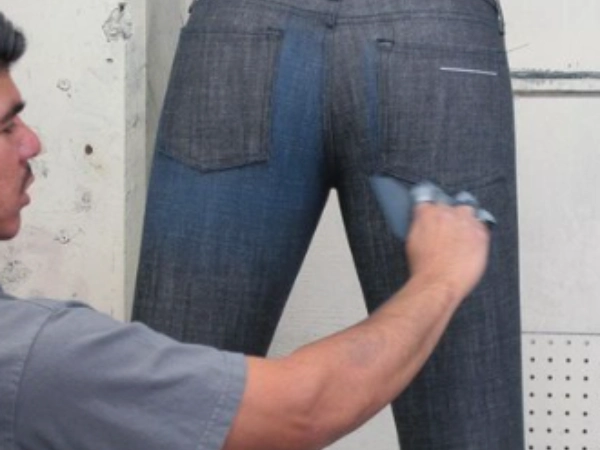Tencel denim fabric, known for its unique properties and sustainable production, has gained popularity in the fashion industry. This fabric is a combination of Tencel, a type of cellulosic fiber, and denim, a versatile and durable cotton fabric. Tencel denim fabric offers a luxurious feel, excellent drape, and superior breathability, making it a preferred choice for many. but can do hand sanding on tencel denim, let’s find an answer from bellowing:
- Understanding Tencel Denim Fabric
- Exploring Hand Sanding
- Preparing for Hand Sanding Tencel Denim Fabric
- Performing Hand Sanding on Tencel Denim
- Best Practices for Hand Sanding Tencel Denim
- Discussing Safety Considerations
- Alternative Methods for Distressing Tencel Denim
Understanding Tencel Denim Fabric
Tencel fabric is derived from cellulose fibers obtained from sustainably sourced wood pulp.
Known for its eco-friendly production process, Tencel fabric is manufactured using a closed-loop system, where over 99% of the chemicals used are recycled. This fabric is also biodegradable, making it a sustainable choice.
Characteristics of Tencel fabric include excellent moisture absorption, softness, and smoothness. Tencel denim fabric combines these qualities with the durability and texture of traditional cotton denim, creating a unique blend that offers comfort and style.
Denim fabric itself has various variations that designers and manufacturers utilize to create different looks and finishes. These variations include raw denim, which is untreated and unwashed, providing the wearer the opportunity to achieve a personalized fade and wear pattern. Other variations include selvage denim, which has a tightly woven edge for increased durability, and stretch denim, which contains a small percentage of elastane for added flexibility and comfort.
By understanding the different variations of denim fabric, one can tailor their hand sanding techniques to achieve the desired effects on Tencel denim fabric. For instance, knowing the density of the fabric can help determine the pressure and duration of hand sanding required to achieve the desired level of distress.
Exploring Hand Sanding
Hand sanding refers to the process of manually distressing or altering the surface of fabric using sandpaper or similar abrasive materials. It is a common technique used in the textile industry to achieve vintage or worn-in effects on denim fabric. Hand sanding allows for precise control over the level of distressing and creates unique patterns and textures.
Benefits of hand sanding Tencel denim include
- Customization
Hand sanding provides the opportunity to create unique and personalized distressing patterns on Tencel denim fabric. This allows designers and manufacturers to offer one-of-a-kind garments with a vintage or lived-in look.
- Artistic Expression
Hand sanding is a creative process that allows artisans to showcase their craftsmanship and artistic skills. It offers a hands-on approach to fabric customization, making each piece a work of art.
- Texture Enhancement
Hand sanding can enhance the texture of Tencel denim fabric by softening rough edges, creating a smoother feel, and adding dimensionality to the fabric.
However, there are some potential drawbacks to consider
- Risk of Over-sanding
Hand sanding requires precision and careful attention to detail. Over-sanding can lead to excessive fabric weakening, holes, or unintended damage. It is essential to start with light sanding and gradually increase pressure or grit if necessary.
- Time-consuming Process
Hand sanding can be a time-intensive process, especially when working with larger fabric pieces or intricate designs. This technique requires patience and dedication to achieve desired results.
Preparing for Hand Sanding Tencel Denim Fabric
- Necessary Supplies and Equipment
- Sandpaper: Choose high-quality sandpaper with various grit options. It is recommended to start with a lower grit (e.g., 80-100) for initial sanding and progressively move to higher grits (e.g., 220-400) for finer finishes.
- Sanding block or sponge: Use a sanding block with a firm, flat surface or a sanding sponge to provide stability and even pressure during the sanding process.
- Protective gear: Wear safety goggles to protect your eyes from dust particles, and consider using a dust mask or respirator to prevent inhalation of fine particles.
- Steps for Prepping the Fabric
- Wash and dry the fabric: Clean the Tencel denim fabric according to the care instructions before sanding. This ensures that any excess dye or chemical finishes are removed to prevent staining the sandpaper.
- Iron the fabric: Use a hot iron to smooth out any wrinkles or creases, ensuring a flat and even surface for sanding.
- Test on an inconspicuous area: Before starting the hand sanding process on the entire fabric, test your desired techniques and sandpaper grits on a small, inconspicuous section to gauge the desired level of distress.
Performing Hand Sanding on Tencel Denim
- Techniques for achieving desired effects
- Light circular motions: Start with gentle pressure and use circular motions to distress the fabric gradually. This technique creates a natural, faded look, reminiscent of natural wear.
- Cross-hatch patterns: For a more pronounced distressed effect, create intersecting lines or cross-hatch patterns using sandpaper. Vary the pressure applied for different levels of distressing.
- Using appropriate pressure and sandpaper grit
- Begin with light pressure: Apply minimal pressure during the initial sanding stages to avoid excessive abrasion. Gradually increase pressure as needed, while monitoring the fabric’s response.
- Determine appropriate grit: Start with a lower grit sandpaper for initial distressing, focusing on key areas such as seams, pockets, and edges. Progress to higher grits for a smoother finish and to prepare the fabric for further treatments or finishes.
Taking proper precautions and practicing these techniques will help achieve the desired distressing effects on Tencel denim fabric while ensuring the fabric remains intact and aesthetically pleasing.
Best Practices for Hand Sanding Tencel Denim
Maintaining consistency in sanding motions
To achieve a uniform and natural-looking distressed effect on Tencel denim fabric, it is important to maintain consistency in your sanding motions. This ensures that the distressing appears deliberate and evenly distributed. Here are some tips to help maintain consistency:
- Use consistent pressure
Apply steady and even pressure throughout the sanding process. Avoid applying excessive force in one area, as this can lead to uneven distressing or unwanted holes.
- Maintain a consistent speed
Keep a steady pace while sanding to ensure uniformity. Rapid or inconsistent sanding movements may result in uneven finishes and irregular patterns.
- Alternate directions
Change the direction of your sanding motions periodically. This prevents the fabric from developing prominent lines or grooves in one specific direction, achieving a more natural and random distressed appearance.
Tips for achieving an even finish
An even finish is desirable when hand-sanding Tencel denim fabric. Here are some tips to help achieve an even result:
- Start with lighter grit sandpaper
Begin with a lower grit sandpaper (around 80-100) for initial distressing. This helps to remove excess dye and create a foundation for more subtle distressing.
- Gradually increase grit
As you progress, move to higher grit sandpaper (220-400) to achieve a finer and smoother finish. This allows for better blending of distressed areas and creates a more cohesive overall appearance.
- Check for consistency
Periodically step back and inspect your work to ensure a consistent level of distress. Adjust your sanding technique or pressure if necessary to achieve an even look.
Discussing Safety Considerations
Protecting oneself during the sanding process
While hand sanding Tencel denim fabric, it is important to prioritize safety and protect yourself from potential hazards. Here are some safety considerations:
- Wear protective goggles: Safeguard your eyes from dust particles by wearing goggles. This prevents eye irritation and potential injury.
- Use a dust mask or respirator: Protect your respiratory system from inhaling fine dust particles by wearing a dust mask or respirator. This is particularly important when sanding for extended periods or in enclosed spaces.
- Consider gloves: Depending on personal preference, wearing gloves can offer additional protection for your hands, especially if you have sensitive skin or are using sandpaper with a coarse grit.
Safe disposal of sanding waste
Proper disposal of sanding waste is essential for maintaining a clean and safe working environment. Follow these guidelines for disposing of sanding waste:
- Collect sanding waste: Place a drop cloth or tarp beneath the fabric being sanded to collect the dust particles and debris that fall off during the process.
- Seal and dispose of waste: Once the sanding is complete, carefully gather the waste materials and seal them in a sturdy bag or container. Dispose of the waste according to local regulations and guidelines for hazardous or abrasive materials.
Alternative Methods for Distressing Tencel Denim
Exploring other ways to achieve a distressed look:
While hand sanding is a popular method for distressing Tencel denim fabric, there are alternative techniques to consider:
- Chemical treatments: Explore the use of fabric-safe chemicals, such as bleach or enzyme washes, to achieve distressed effects. These treatments can fade the color or create unique patterns when applied selectively.
- Laser or mechanical distressing: By using specialized laser machines or mechanical devices, such as sandblasters or pumice stones, distressing effects can be achieved with precision and uniformity.
Comparing the pros and cons of each method:
Here are some factors to consider when comparing alternative distressing methods:
- Level of control: Hand sanding allows for precise control over distressing patterns and intensity. Chemical treatments, laser, or mechanical distressing methods may offer more consistent and controlled results.
- Time and efficiency: Hand sanding can be time-consuming, especially for larger fabric pieces. Alternative methods may offer faster and more efficient distressing options for mass production.
- Skill and equipment requirements: Hand sanding requires minimal equipment and can be done with basic supplies. Alternative methods may require specialized equipment, training, or professional expertise.
En conclusión, lijar a mano la tela de mezclilla de Tencel ofrece la oportunidad de personalización, expresión artística y mejora de la textura. Al mantener la consistencia en los movimientos de lijado y seguir las mejores prácticas, se puede lograr un acabado uniforme. Las consideraciones de seguridad, como protegerse durante el proceso y deshacerse adecuadamente de los residuos de lijado, son cruciales. Explorar métodos alternativos de desgaste permite diferentes estilos y efectos, cada uno con sus propias ventajas y desventajas. En última instancia, es importante experimentar y adaptar la técnica de desgaste a las preferencias individuales, creando resultados únicos y hermosos en la tela de mezclilla de Tencel.





